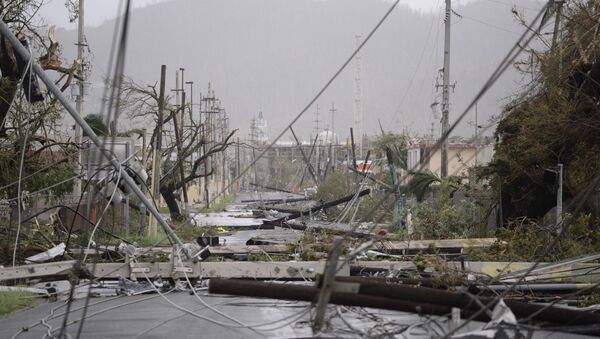"There is a humanitarian crisis in [Puerto Rico]," the politician tweeted at Trump Tuesday. "We need food, diesel, water and logistics support."
— Carmen Yulín Cruz (@CarmenYulinCruz) September 26, 2017
Acknowledging the dire situation, Trump later informed reporters he'd go to the island on October 3. He is also expected to visit the US Virgin Islands, which sustained major damage during Hurricane Irma and was then walloped again by Maria just days later.
"Puerto Rico needs a lot of money; I am going to Puerto Rico on [next] Tuesday," Trump told White House reporters. "It's the earliest I can go because of the first responders, and we don't want to disrupt the relief efforts."
— Kyle Griffin (@kylegriffin1) September 26, 2017
Amid speculation that the Trump administration was not giving an adequate response to the unfolding situation, Trump later added that "tremendous amounts" of relief supplies were arriving "on an hourly basis," and that "we're working very very hard."
According to a statement by the US military officials estimate they will be able "to increase airlift flow rate to coordinate a total of 240 airlifts into the US Virgin Islands and Puerto Rico within the next 24 hours. Authorities also stated approximately 44 percent of the population is "without drinking water."
"Puerto Rico is very important to me," Trump said. "The people are fantastic people. I grew up in New York, so I know many people from Puerto Rico. I know many Puerto Ricans, and these are great people and we have to help them."
While POTUS' visit is days away, travelers are hopelessly waiting their turn to leave Puerto Rico, but it's a more alarming situation than just your run-of-the-mill departure lounge.
Stranded in a packed airport with no electricity, no air conditioning, and limited food and water supplies, hundreds are eagerly waiting to board their flights at San Juan's Luis Marín Muñoz International Airport.
"Everything is hearsay at the moment because there is no communication," Rene Kessler, a medical student from Baltimore, Maryland, told Reuters.
Getting ready to hunker down and spend the night in the airport, Kessler isn't alone, though. In fact, she's joined by several others.
"It's like the end of the world," Andrew Arteaga, who spent five nights at the airport with his wife and 8-month-old daughter, told USA Today. "No A/C, no nothing, we're just sweating in here. They don't even give us water."
— David Begnaud (@DavidBegnaud) September 25, 2017
"None of this is right," the frustrated father said.
With the airport's radar system knocked out, dozens of flights were cancelled. Officials only began to arrange commercial flights out of the battered city Friday, however, starting with just two flights a day, their efforts did not make much of a dent in the hundreds trying to leave.
"FAA technicians are working around the clock to restore services," the Federal Aviation Administration said in a statement Sunday. "But because of the extent of the damage and challenges of the terrain where equipment is located, it's difficult to determine a timeline for the full restoration of service."
— David Begnaud (@DavidBegnaud) September 24, 2017
And yet while many are sticking it out to see when their flight is boarding, the roughly 3.5 million Americans living in Puerto Rico are in for a tough road ahead.
"We lost our house, it was completely flooded," Carmen Lamb, a resident near Guajataca told Reuters. "We lost everything. Cars, clothes, everything."
Lamb is among 70,000 people who live in a river valley below the Guajataca Dam, which is dealing with structural damage thanks to Maria's 155 mph winds and torrential rainfall that raised the level of the reservoir by several feet in only hours. The northwestern region of the Island of Enchantment has been under evacuation since Friday after authorities announced the dam was in danger of imminent collapse.
— WeatherNation (@WeatherNation) September 22, 2017
According to Reuters, Maria brought on an estimated $45 billion worth of damages across the Caribbean — at least $30 billion is attributed to the havoc that Puerto Rico was handed.
On Monday, Governor Ricardo Rosselló confirmed the storm killed 16 people on the island, bringing the overall death toll in the Caribbean to 49.



